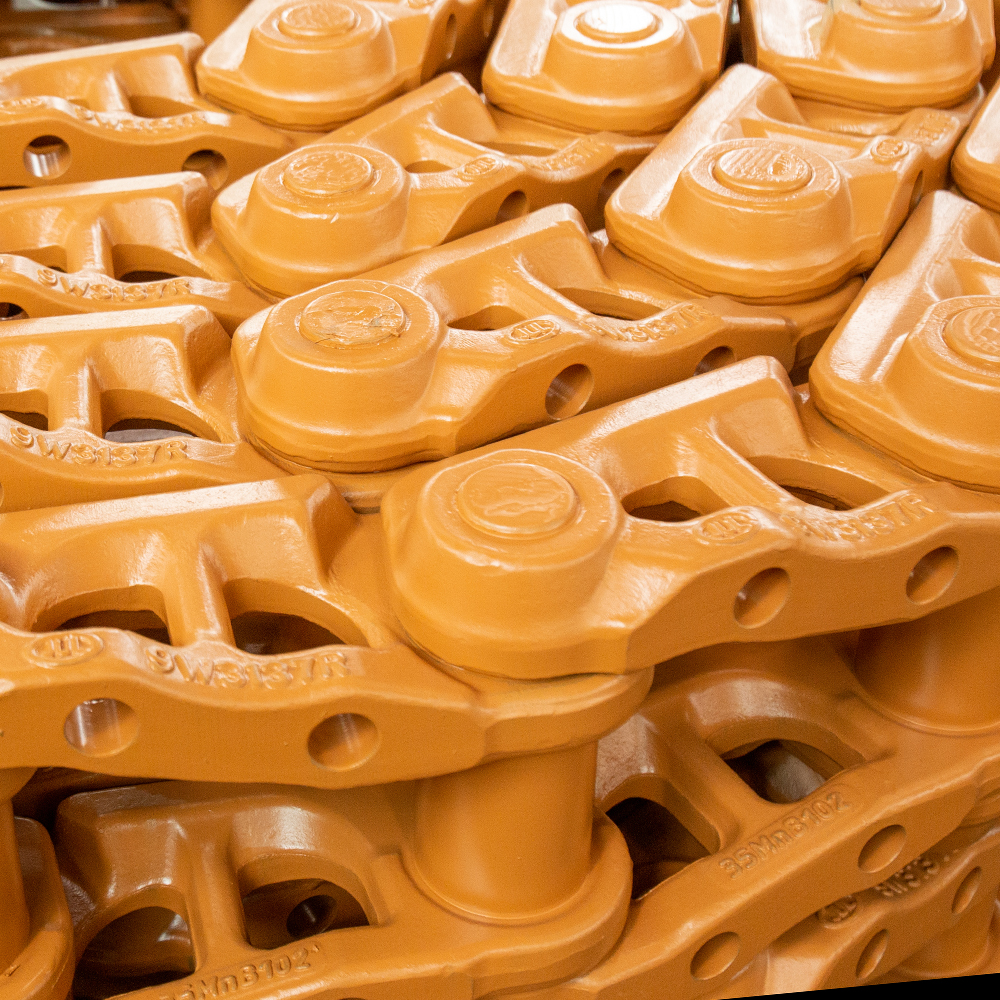Excavator track links play a crucial role in the overall efficiency and productivity of an excavation project.
Here’s how they contribute to these factors:
Traction and Stability: The track links, along with the other components of the track system, provide traction and stability to the excavator. They allow the machine to traverse various terrains, including soft soils, uneven surfaces, and steep slopes. This increased traction enables the excavator to maintain stability while digging, lifting, and maneuvering, thereby enhancing efficiency and safety.
Weight Distribution: The track links distribute the weight of the excavator over a larger surface area, reducing the ground pressure exerted by the machine. This helps prevent sinking or getting stuck in soft or muddy soil conditions. By minimizing ground disturbance and maintaining stability, the excavator can work more efficiently and complete tasks without delays.
Enhanced Maneuverability: The track links allow the excavator to move smoothly and maneuver in tight spaces. The independent movement of the tracks enables the machine to rotate on the spot, make precise turns, and navigate through confined areas. This maneuverability increases productivity by reducing the need for repositioning and optimizing the use of available workspace.
Versatility and Adaptability: Excavator track links are available in different sizes and configurations to suit various excavation projects and ground conditions. They can be equipped with additional features like rubber pads or bolt-on shoes for specific applications. This versatility allows the excavator to adapt to different terrains and work efficiently across a range of projects, enhancing overall productivity.
Reduced Ground Damage: The design and construction of excavator track links minimize ground damage during operation. They distribute the machine’s weight more evenly, reducing the likelihood of soil compaction or surface disruption. This is particularly important in sensitive environments or areas where restoration or landscaping is required after excavation. By minimizing ground damage, the project can progress smoothly and reduce the need for corrective measures.
Longevity and Reliability: High-quality excavator track links are designed to withstand the demanding conditions of excavation projects. They are made from durable materials and undergo rigorous testing to ensure longevity and reliability. By using reliable track links, the risk of breakdowns, downtime, and associated productivity losses is minimized, allowing the project to proceed efficiently.
In summary, excavator track links contribute to the overall efficiency and productivity of an excavation project by providing traction, stability, maneuverability, adaptability, and minimizing ground damage. Their reliable performance allows the excavator to work efficiently, complete tasks on schedule, and optimize the use of available resources.
How does the design of excavator track links affect the machine’s stability and maneuverability?
The design of excavator track links plays a significant role in determining the machine’s stability and maneuverability.
Here’s how the design factors influence these aspects:
Track Width: The width of the track links affects the excavator’s stability. Wider track links provide a larger surface area in contact with the ground, distributing the machine’s weight more evenly. This wider footprint increases stability, especially when working on uneven or soft terrain, reducing the risk of tipping or sinking.
Track Length: The length of the track links impacts the machine’s maneuverability. Longer track links allow for smoother movements and improved weight distribution during turns. This enables the excavator to make more precise and controlled maneuvers,excavator track links enhancing overall maneuverability in tight spaces or restricted job sites.
Track Shoe Configuration: The configuration of the track shoes that attach to the track links can influence stability and maneuverability. Different types of shoe configurations, such as standard shoes, flat pads, or triple grouser shoes, offer varying levels of traction, stability, and ground penetration. The choice of shoe configuration depends on the specific application and ground conditions.
Track Link Pitch: The pitch refers to the distance between the centerlines of two adjacent track links. The track link pitch affects the smoothness of the excavator’s movement and its ability to transition over obstacles. An optimal track link pitch ensures a balanced combination of stability and maneuverability, allowing the machine to navigate uneven terrain while maintaining stability.
Track Link Material and Construction: The material and construction of the track links impact both stability and maneuverability. High-quality materials, such as hardened steel or alloy, provide durability and strength, ensuring the track links can withstand heavy loads and rugged operating conditions. Additionally, the design of the track links, including reinforcement and support structures, contributes to their overall stability and resistance to bending or deformation.
Track Link Suspension System: Some excavators feature a suspension system incorporated into the design of the track links. This system utilizes hydraulic or mechanical components to absorb shocks and vibrations, enhancing stability during operation. The suspension system helps improve operator comfort, reduce machine fatigue, and maintain stability, especially when working on rough or uneven terrain.
By carefully considering and optimizing these design factors, excavator track links can be tailored to provide a balance between stability and maneuverability. This enables the machine to operate efficiently, maintain control during various tasks, and navigate challenging terrain with confidence.
